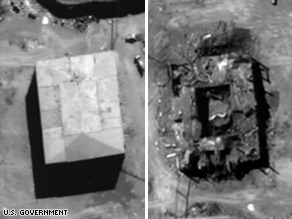Setting the Record Straight on Israel’s 2007 Bombing of an Alleged Syrian Nuclear Reactor

Featured image: Before and after picture of building struck during Operation Orchard in Syria (Source: Wikimedia Commons)
VISIT MY NEW WEB SITE:
Contact at [email protected].
After saying nothing about the incident for over a decade, the IDF falsely claimed it destroyed a Syrian nuclear reactor in 2007 before it became active.
Israeli and Western media are all over the story, reporting the ruse, what Haaretz called former prime minister Ehud Olmert’s “finest hour” – a shameful perversion of what actually happened.
Syria had no nuclear reactor. Claims otherwise were fabricated. A lawless IDF September 6, 2007 attack indeed occurred on its territory.
At the time, anonymous sources claimed Israel destroyed a partially constructed nuclear reactor.
None existed. The site attacked had nothing to do with nuclear reactor development. Israel committed premeditated aggression. It wasn’t the first or last time.
In February 2008, investigative journalist Seymour Hersh explained what happened, his article headlined “A Strike in the Dark,” saying:
At least four “low-flying” IDF warplanes entered Syrian airspace illegally.
Unprovoked, they “carried out a secret bombing mission on the banks of the Euphrates River, about ninety miles north of the Iraq border.”
Syria denounced the incident. Assad admitted Israeli warplanes struck their intended target – an “unused military building,” he explained, not a “nascent nuclear reactor,” as anonymous sources claimed.
Media reports at the time cited an unconfirmed North Korean connection to an eastern Syrian agricultural area construction site, adding:
Days before the bombing incident, a North Korean ship arrived at Syria’s Tartus port city. Satellite imagery falsely claimed a building under construction “was designed to hold a nuclear reactor when completed,” Hersh explained.
Reportedly, Washington signed off on the Israeli bombing. The Olmert regime and IDF maintained silence about it.
Hersh:
“(I)n three months of reporting” following the incident, “I was repeatedly told by current and former intelligence, diplomatic, and congressional officials that they were not aware of any solid evidence of ongoing nuclear-weapons programs in Syria” – because there was none.
Then IAEA director-general Mohamed ElBaradei issued a statement saying:
“Our experts who have carefully analyzed the satellite imagery say it is unlikely that this building was a nuclear facility.”
Center for American Progress director for nuclear policy Joseph Cirincione said
“Syria does not have the technical, industrial, or financial ability to support a nuclear-weapons program,” adding:
“I’ve been following this issue for 15 years, and every once in a while a suspicion arises and we investigate and there’s nothing.”
“There was and is no nuclear-weapons threat from Syria. This is all political. (S)ome of our best journalists were used.”
Hersh explained similar information came from congressional members weeks after the bombing, following intelligence briefings – including about an alleged North Korean connection.
At the time, an unnamed congressional member said
“(t)here’s nothing that proves any perfidy involving the North Koreans.”
Hersh stressed “serious and unexamined contradictions” in published accounts of the incident.
An unnamed IAEA official mocked the notion that the Syrian building under construction was for a nuclear reactor, saying “(a) square building is a square building” – nothing else, nothing sinister or illegal about it.
Before the bombing, a former State Department intelligence expert told Hersh there was no security around the building in question, adding:
“No barracks for the Army or the workers. No associated complex.”
Nonproliferation expert Jeffrey Lewis said the building wasn’t high enough to house a Yongbyon-size reactor – with enough room to extract control rods.
Nor did satellite imagery indicate major underground construction. Lewis added “(a)ll you could see was a box. You couldn’t see enough to know how big it will be or what it will do. It’s just a box” like countless other buildings.
A former senior US intelligence official with access to current information told Hersh:
“We don’t have any proof of a reactor – no signals intelligence, no human intelligence, no satellite intelligence.”
A Syrian Foreign Ministry official told Hersh the site Israel struck “was an old military building that had been abandoned by the Syrian military. What they targeted was a building used for fertilizer and water pumps.”
Soil samples of the targeted site would have found “only cement.” Hersh believes
“(w)hatever was under construction, with North Korean help, it apparently had little to do with agriculture – or with nuclear reactors – but much to do with Syria’s defense posture, and its military relationship with North Korea,” adding:
According to a former US intelligence official, “America’s involvement in the Israeli raid dated back months earlier, and was linked to the Administration’s planning for a possible air war against Iran.”
Hersh is highly respected, his reports credible. In September 2007, Israeli warplanes did not target and destroy a Syrian nuclear reactor – as reported at the time, what Israel for the first time now falsely claims.
Netanyahu lied tweeting:
“The Israeli government, the Israel Defense Forces and the Mossad prevented Syria from developing nuclear capability,” adding:
“They are worthy of full praise for this. Israel’s policy was and remains consistent – to prevent our enemies from arming themselves with nuclear weapons.”
Israel is the only regional armed and dangerous nuclear power since the atom was split.
Neither Iran, Syria or any other Middle East country pursued development of these weapons earlier or now.
Claims otherwise are bald-faced lies.
*
Stephen Lendman is a Research Associate of the CRG, Correspondent of Global Research based in Chicago.
VISIT MY NEW WEB SITE: stephenlendman.org (Home – Stephen Lendman). Contact at [email protected].
My newest book as editor and contributor is titled “Flashpoint in Ukraine: How the US Drive for Hegemony Risks WW III.”

